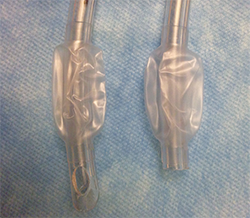
Explore This Issue
ACEP Now: Vol 34 – No 05 – May 2015Figure 1. Equipment needed for the assembly of the alternative to the Hurst dilator and the bougienage.
1. Foley catheter
2. Endotracheal tube
3. 10cc syringe with water
4. Tape
5. Tongue depressors (approximately 5–6) taped together to act as a bite block
Hurst dilators are reusable, flexible silicone-based devices that are more commonly used for dilatation of benign esophageal sphincters but are also used off-label for bougienage. Most pediatric centers will have access to these through their operating or endoscopy suites. For emergency physicians who do not have easy access to one of these, we offer a potential alternative made of products commonly found in every emergency department across the country.
Assembling an Alternative to the Hurst Dilator
After gathering the equipment (Figure 1), you’ll need to cut the tip of the endotracheal (ET) tube in a perpendicular manner at the distal aspect of the cuff, as shown in Figure 2. Try to avoid forming any sharp corners on the ET tube when making this cut. For the smallest children, likely between 1 and 2 years old, you’ll have to trim the ET tube proximal to the cuff so that the Foley balloon reaches the end of the ET tube. Next, you’ll take the proper-sized Foley and feed it through the ET tube, as in Figure 3. Inflate the balloon to the specified amount (see Table 1) with sterile water and then pull traction on the Foley through the opposite end of the ET tube so that the Foley balloon is held firmly against the distal tip of the ET tube. The operator can either maintain traction on the device throughout the procedure or secure it with tape (see Figure 3).

Figure 2. Cut the tip of the endotracheal tube in a perpendicular manner just distal to the cuff.
This can now serve as your substitute for a Hurst dilator for the bougienage procedure.
The ET tube is necessary for the production of an alternative to a Hurst dilator because the Foley catheter alone does not provide enough rigidity to manipulate and advance the coin. If you were to use the Foley catheter without the addition of the ET tube, you may be able to reach the esophageal coin but not successfully advance it into the stomach. Please use this alternative device at your own discretion because use of this device has not been studied to support its use for bougienage.

Figure 3. Place the Foley catheter through the ET tube completely (Top left). Inflate the Foley catheter to the predetermined volume and place traction on the opposite end to have it flush against the distal tip of the ET tube (Top right). Option to secure the Foley catheter to the ET tube (Bottom).

(click for larger image)
Table 1. Proper Sizing of Hurst Dilator and Equivalent-Sized Equipment for Facilities Without Access to Hurst Dilators
Pages: 1 2 | Multi-Page





One Response to “How To Build a Substitute for a Hurst Dilator for Use in Bougienage”
May 29, 2021
Emily RandJust wanted to say that I used this today and this was a fantastic reference!!